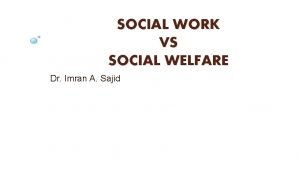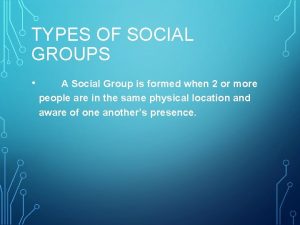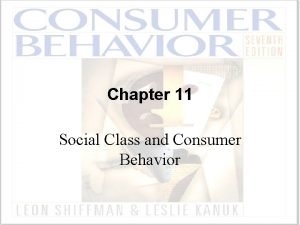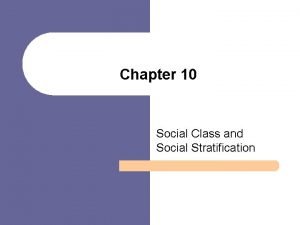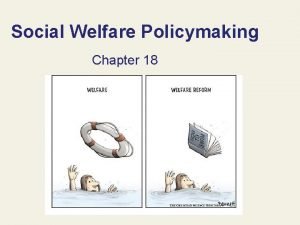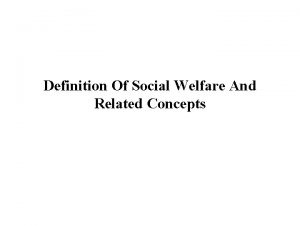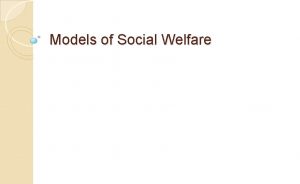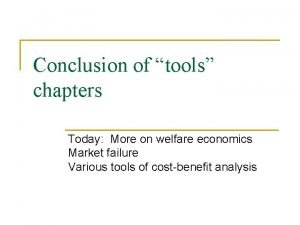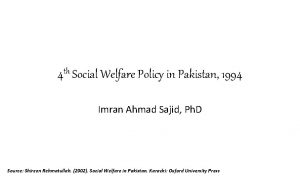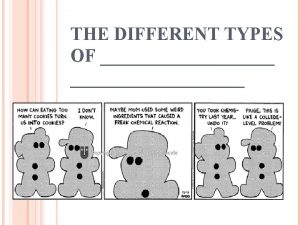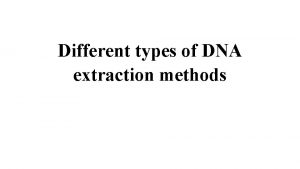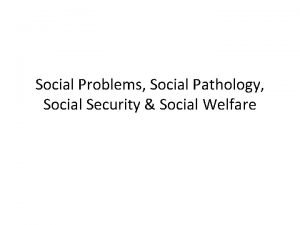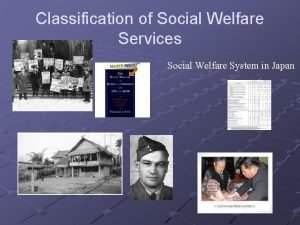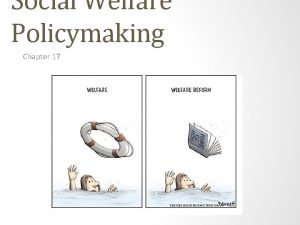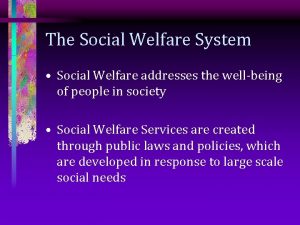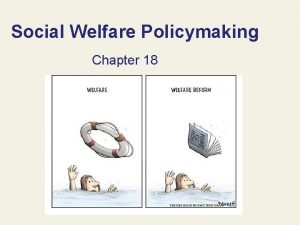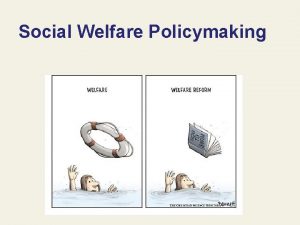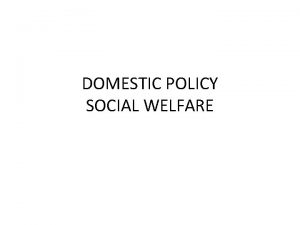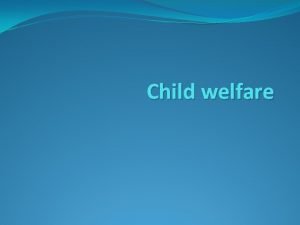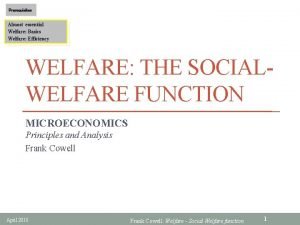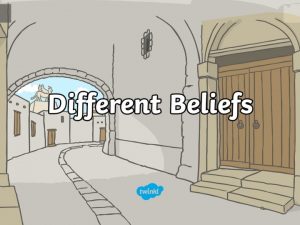Social Welfare 5 3 Different types of Welfare























- Slides: 23

Social Welfare 5. 3

Different types of Welfare • What is welfare? • the health, happiness, and fortunes of a person or group. • statutory procedure or social effort designed to promote the basic physical and material well-being of people in need. • Two different types: • Majoritarian: Social Security and Medicare • Client: Food stamps and Medicaid

Office of Assistant Secretary for Planning & Evaluation

Income, Poverty, and Public Policy

Income, Poverty, and Public Policy ◦ 125% of Poverty Line for family of four is $28, 800 ◦ Equals less than $20 per day, per family member ◦ From this amount all food, clothing, medical and entertainment costs must be paid ◦ Average rent in the U. S. is $804, when subtracting this amount, this family must survive on $13 per day, person. ◦ Average rent in Charlotte is $1347 ◦ “CHARLOTTE, NC (WBTV) -A team from Harvard found poor children raised in Mecklenburg County are among the least likely in the country to escape poverty as adults. Mecklenburg was second only to Baltimore County, Maryland. ”

The Demographics of Poverty






Social Welfare and the united states Social Welfare Policy has developed differently in the Unites States than in most other nations. How? 1. Americans have a more restrictive view on who is entitled to government assistance (Who deserves the welfare benefits? ) 2. Welfare state arrived late in comparison to other nations. It was not until the 1930 s (Social Security Act of 1935) that allowed us to enact social welfare policy. 22 nations at this time already had similar programs. 3. The impact of federalism on Welfare. States play a large role in running welfare programs. 4. Nongovernmental organizations play a LARGE role in welfare

Cornerstone of social welfare programs 1. Social Security Act of 1935 The great depression overwhelmed private charities and city relief programs that had helped the needy before. President Franklin D. Roosevelt helped create the Social Security Act of 1935 Provided TWO kinds of programs: 1. Insurance for the retired, to which workers would contribute and from which they would benefit when they became elderly. (Insurance Program) Any one can qualify, no means test given 2. Provide assistance for dependent children, the blind, and the elderly. The federal government would use its power to tax to provide the funds (Assistance Program) Means Tests: A measure to determine that incomes are below a certain level ** The idea of having the government pay for the medical and hospital bills of the elderly and the poor had been discussed, but was left out to ensure the passage of the Social Security Act.

Cornerstone of social welfare programs 2. The Medicare Act of 1965 1964 elections brought a huge Democratic majority in Congress The bill only applied to those eligible for Social Security Originally, the bill only covered hospital expenses and not doctor’s visits. Got changes in committee to cover doctor bills and to est. Medicaid Both the Social Security and Medicare implement MAJORITATIAN POLITICS

Reforming Welfare programs Both Social Security and Medicare currently under scrutiny because of potential problems some see in the future. There will soon be an insufficient number of people paying Social Security taxes to provide benefits for every retired person. By 2020… so 1 and half years workers will have to double their S. S. Tax to pay for retirees SOLUTIONS? 1. Raising the retirement age to 70 and raising Social Security Tax 2. Reduce benefits for high-earners 3. Raise payroll taxes 4. Increase the wage cap 5. Have the gov’t make investments 6. Let individuals make investments


Problems with Medicare Way too expensive! Estimated to cost $12 billion a year in 1990, but actually cost $110 billion WHY? 1. A lot of people use medical services that they do not need (hospitals and doctors get paid a fee for every visit) 2. Doctors and hospitals overcharge the government for their services SOLUTIONS? 1. Get rid of Medicare and have doctors and hospitals word for the government. 2. Let the elderly take their Medicare money and buy health insurance from private suppliers ** Cutting benefits never goes over well, it would be political suicide. ** Interest groups such as AARP (American Association of Retired Persons) keep lobbying to protect benefits


The Aid to Families with Dependent Children One part of the Social Security Act of 1935 that was scarcely noted at the time. This is one example of CLIENT POLITICS Initially, money was given to states to help them pay for already running programs to help poor children that did not have a father. States had control. They decided what constituted a “need” to set benefit levels, and now to administer the program. There were some federal government regulations: -Women must identify the father -States had to set up mandatory job training programs -Determined how to calculate income -Must give Medicaid to AFDC recipients

Aid to families with dependent children The federal government also created additional programs such as: 1. Earned Income Tax Credit: A provision that entitled working families with children to receive money from the government if their total income is below a certain level 2. Food stamps 3. Free and reduced lunch PUBLIC OPINION STARTED MOVING AGAINST AFDC programs WHY? -public viewed recipients as undeserving -increasing numbers of unwed mothers who stayed on assistance for more than 8 years -states were constrained by a growing number of federal regulations -Lost political legitimacy

AFDC REFORM In 1996, Aid To Families with Dependent Children (AFDC) was abolished Temporary Assistance for Needy Families (TANF) took its place. Each state is given a federal block grant to pay for the costs of running TANF. Adults can only receive benefits for 5 years Aid is reduced to women that can not identify the fathers

The Affordable Care Act How does the ACA (Obamacare) fall under social welfare programs

The Future of Social Welfare Policy Elsewhere ◦ Many industrialized nations have much more extensive social welfare programs than the U. S. ◦ But the tax rates are higher in those countries than in the U. S. ◦ Other countries (especially in the EU) are reforming their welfare programs. Cuts to social programs are called “austerity measures. ”
 Social welfare vs social work
Social welfare vs social work Different types of social group
Different types of social group Different types of social groups
Different types of social groups Types of social groups in sociology
Types of social groups in sociology Consumer behavior social class
Consumer behavior social class System of stratification
System of stratification Voluntary group and involuntary group examples
Voluntary group and involuntary group examples Social thinking adalah
Social thinking adalah Social thinking social influence social relations
Social thinking social influence social relations Welfare programs in the us
Welfare programs in the us Industrial achievement performance model
Industrial achievement performance model Objectives of social group work
Objectives of social group work What is welfare
What is welfare Social welfare models
Social welfare models Conclusion of social welfare
Conclusion of social welfare 2nd social welfare policy in pakistan
2nd social welfare policy in pakistan Economic ethics
Economic ethics Social welfare in colombia
Social welfare in colombia Ethics and social welfare
Ethics and social welfare Describe the classification of labour welfare in india
Describe the classification of labour welfare in india Thermosoftening plastics examples
Thermosoftening plastics examples Technicolor test
Technicolor test Sound will travel at different speeds in different mediums.
Sound will travel at different speeds in different mediums. Examples of a medium in waves
Examples of a medium in waves
